Business Law 1: Contract Law, Agency, and Legal Relations Assignment
VerifiedAdded on 2020/04/01
|10
|2909
|265
Homework Assignment
AI Summary
This Business Law 1 assignment delves into the core principles of contract law. It begins by outlining the essential elements required to establish a binding contract, including offer, acceptance, consideration, intention to create legal relations, capacity, and legality, providing detailed explanations and relevant case examples for each. The assignment then addresses whether contracts must be written to be binding, clarifying the role of the Statute of Frauds and the advantages of written agreements. Furthermore, it distinguishes between formal and informal contracts, offering examples of formal contracts and their formalities. The assignment also examines the legal implications of a group of friends winning a lottery and refusing to share the winnings, analyzing the intention to create legal relations. Finally, the assignment explores the distinction between an agent and an independent contractor, highlighting the legal implications of each relationship, particularly concerning liability and control. The assignment utilizes legal precedents to support the arguments and provides a comprehensive understanding of the topics covered.
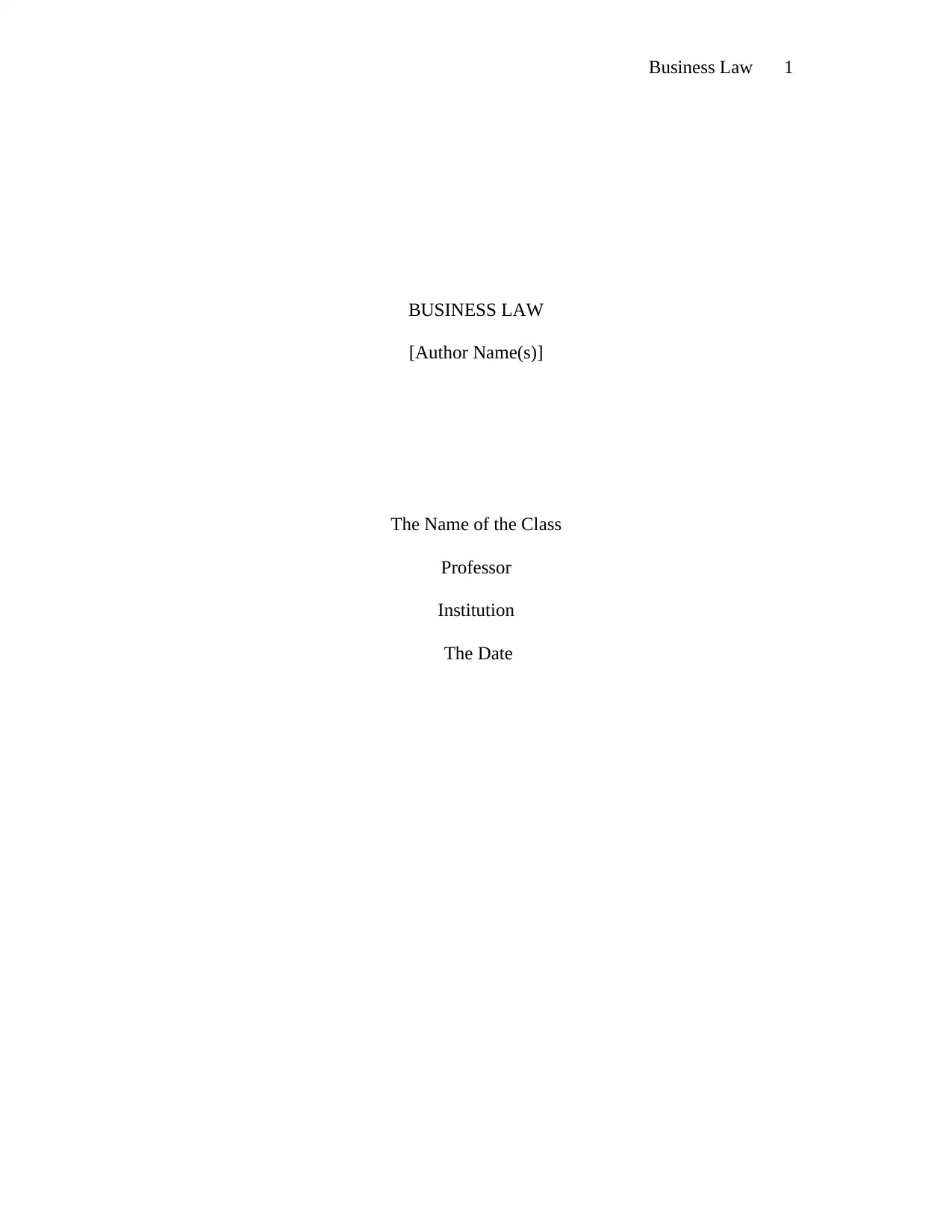
Business Law 1
BUSINESS LAW
[Author Name(s)]
The Name of the Class
Professor
Institution
The Date
BUSINESS LAW
[Author Name(s)]
The Name of the Class
Professor
Institution
The Date
Paraphrase This Document
Need a fresh take? Get an instant paraphrase of this document with our AI Paraphraser
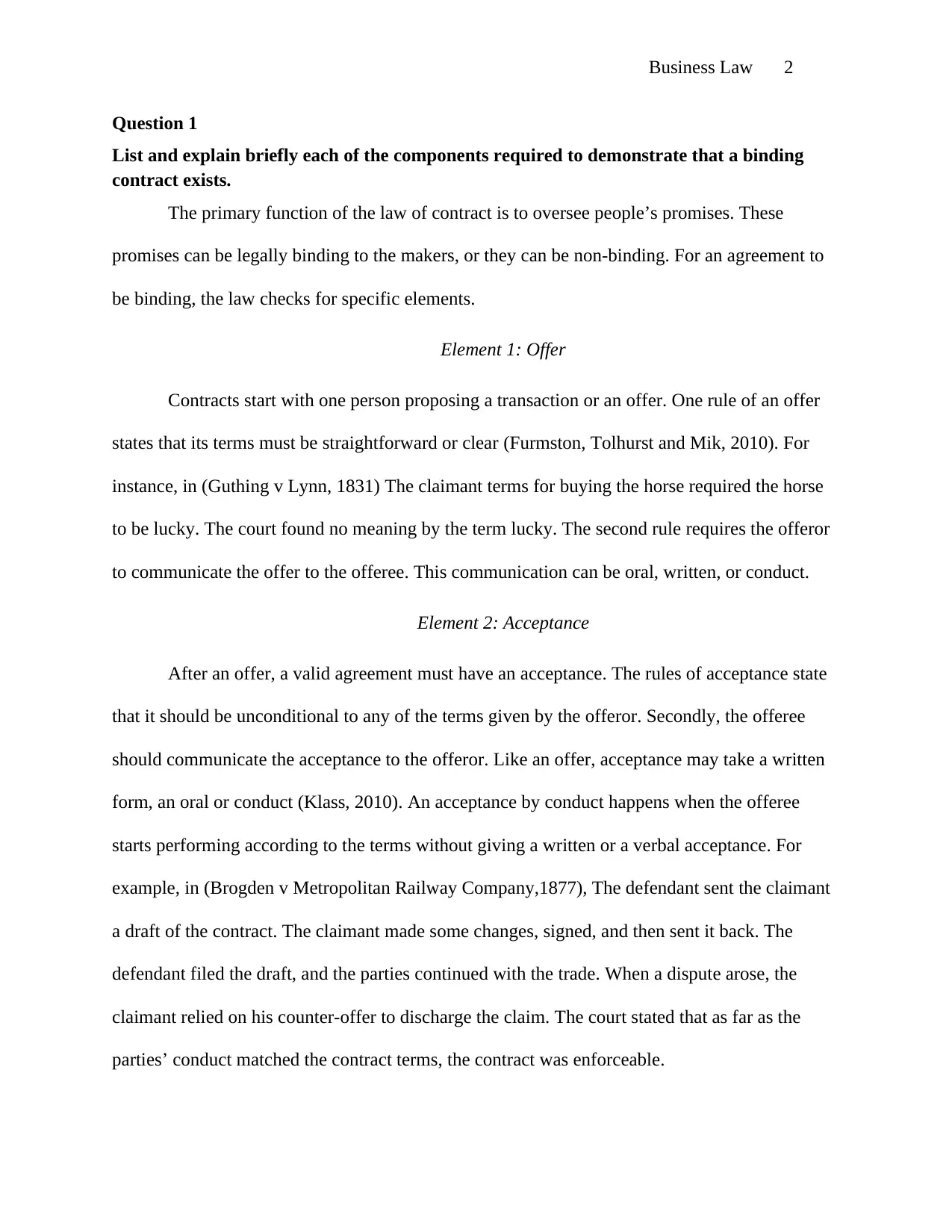
Business Law 2
Question 1
List and explain briefly each of the components required to demonstrate that a binding
contract exists.
The primary function of the law of contract is to oversee people’s promises. These
promises can be legally binding to the makers, or they can be non-binding. For an agreement to
be binding, the law checks for specific elements.
Element 1: Offer
Contracts start with one person proposing a transaction or an offer. One rule of an offer
states that its terms must be straightforward or clear (Furmston, Tolhurst and Mik, 2010). For
instance, in (Guthing v Lynn, 1831) The claimant terms for buying the horse required the horse
to be lucky. The court found no meaning by the term lucky. The second rule requires the offeror
to communicate the offer to the offeree. This communication can be oral, written, or conduct.
Element 2: Acceptance
After an offer, a valid agreement must have an acceptance. The rules of acceptance state
that it should be unconditional to any of the terms given by the offeror. Secondly, the offeree
should communicate the acceptance to the offeror. Like an offer, acceptance may take a written
form, an oral or conduct (Klass, 2010). An acceptance by conduct happens when the offeree
starts performing according to the terms without giving a written or a verbal acceptance. For
example, in (Brogden v Metropolitan Railway Company,1877), The defendant sent the claimant
a draft of the contract. The claimant made some changes, signed, and then sent it back. The
defendant filed the draft, and the parties continued with the trade. When a dispute arose, the
claimant relied on his counter-offer to discharge the claim. The court stated that as far as the
parties’ conduct matched the contract terms, the contract was enforceable.
Question 1
List and explain briefly each of the components required to demonstrate that a binding
contract exists.
The primary function of the law of contract is to oversee people’s promises. These
promises can be legally binding to the makers, or they can be non-binding. For an agreement to
be binding, the law checks for specific elements.
Element 1: Offer
Contracts start with one person proposing a transaction or an offer. One rule of an offer
states that its terms must be straightforward or clear (Furmston, Tolhurst and Mik, 2010). For
instance, in (Guthing v Lynn, 1831) The claimant terms for buying the horse required the horse
to be lucky. The court found no meaning by the term lucky. The second rule requires the offeror
to communicate the offer to the offeree. This communication can be oral, written, or conduct.
Element 2: Acceptance
After an offer, a valid agreement must have an acceptance. The rules of acceptance state
that it should be unconditional to any of the terms given by the offeror. Secondly, the offeree
should communicate the acceptance to the offeror. Like an offer, acceptance may take a written
form, an oral or conduct (Klass, 2010). An acceptance by conduct happens when the offeree
starts performing according to the terms without giving a written or a verbal acceptance. For
example, in (Brogden v Metropolitan Railway Company,1877), The defendant sent the claimant
a draft of the contract. The claimant made some changes, signed, and then sent it back. The
defendant filed the draft, and the parties continued with the trade. When a dispute arose, the
claimant relied on his counter-offer to discharge the claim. The court stated that as far as the
parties’ conduct matched the contract terms, the contract was enforceable.
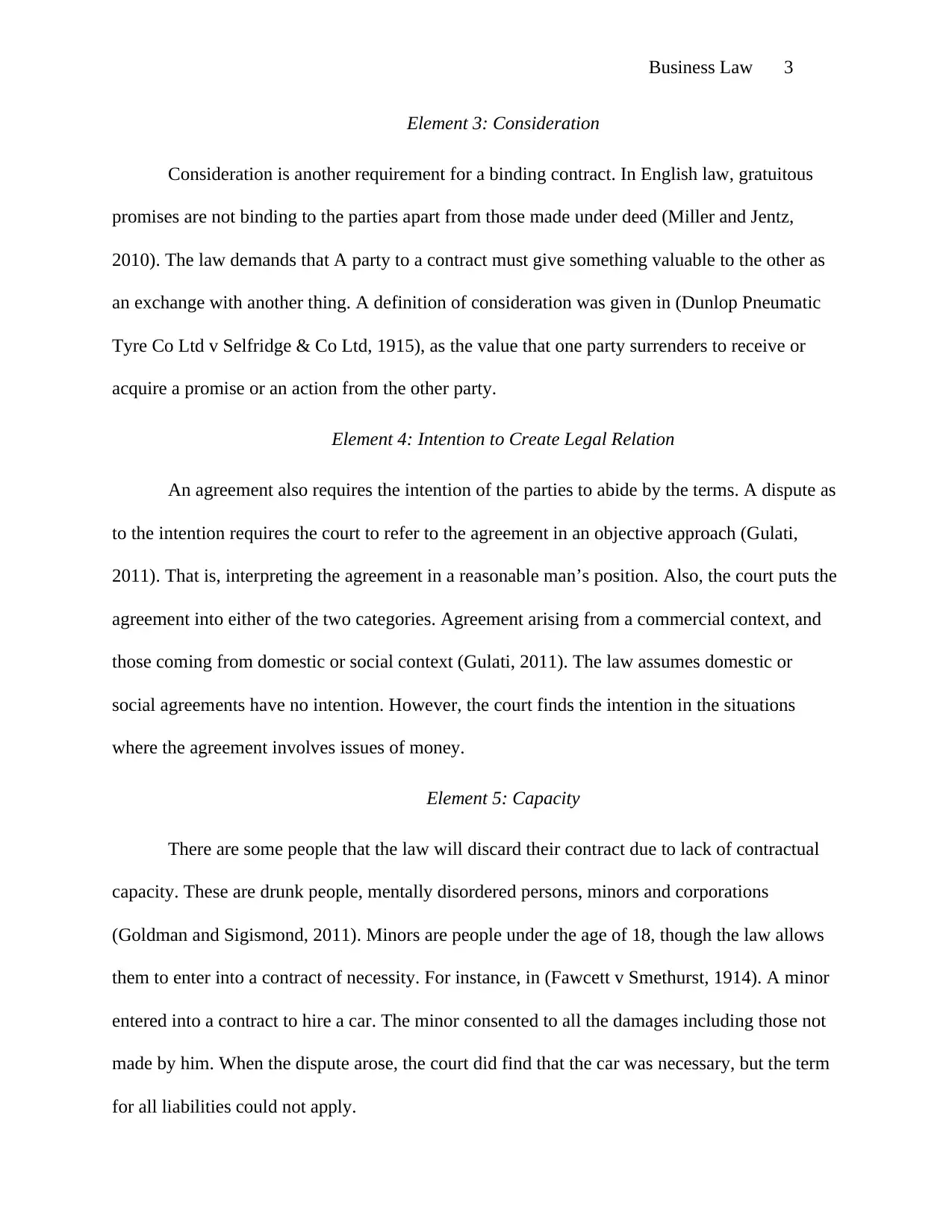
Business Law 3
Element 3: Consideration
Consideration is another requirement for a binding contract. In English law, gratuitous
promises are not binding to the parties apart from those made under deed (Miller and Jentz,
2010). The law demands that A party to a contract must give something valuable to the other as
an exchange with another thing. A definition of consideration was given in (Dunlop Pneumatic
Tyre Co Ltd v Selfridge & Co Ltd, 1915), as the value that one party surrenders to receive or
acquire a promise or an action from the other party.
Element 4: Intention to Create Legal Relation
An agreement also requires the intention of the parties to abide by the terms. A dispute as
to the intention requires the court to refer to the agreement in an objective approach (Gulati,
2011). That is, interpreting the agreement in a reasonable man’s position. Also, the court puts the
agreement into either of the two categories. Agreement arising from a commercial context, and
those coming from domestic or social context (Gulati, 2011). The law assumes domestic or
social agreements have no intention. However, the court finds the intention in the situations
where the agreement involves issues of money.
Element 5: Capacity
There are some people that the law will discard their contract due to lack of contractual
capacity. These are drunk people, mentally disordered persons, minors and corporations
(Goldman and Sigismond, 2011). Minors are people under the age of 18, though the law allows
them to enter into a contract of necessity. For instance, in (Fawcett v Smethurst, 1914). A minor
entered into a contract to hire a car. The minor consented to all the damages including those not
made by him. When the dispute arose, the court did find that the car was necessary, but the term
for all liabilities could not apply.
Element 3: Consideration
Consideration is another requirement for a binding contract. In English law, gratuitous
promises are not binding to the parties apart from those made under deed (Miller and Jentz,
2010). The law demands that A party to a contract must give something valuable to the other as
an exchange with another thing. A definition of consideration was given in (Dunlop Pneumatic
Tyre Co Ltd v Selfridge & Co Ltd, 1915), as the value that one party surrenders to receive or
acquire a promise or an action from the other party.
Element 4: Intention to Create Legal Relation
An agreement also requires the intention of the parties to abide by the terms. A dispute as
to the intention requires the court to refer to the agreement in an objective approach (Gulati,
2011). That is, interpreting the agreement in a reasonable man’s position. Also, the court puts the
agreement into either of the two categories. Agreement arising from a commercial context, and
those coming from domestic or social context (Gulati, 2011). The law assumes domestic or
social agreements have no intention. However, the court finds the intention in the situations
where the agreement involves issues of money.
Element 5: Capacity
There are some people that the law will discard their contract due to lack of contractual
capacity. These are drunk people, mentally disordered persons, minors and corporations
(Goldman and Sigismond, 2011). Minors are people under the age of 18, though the law allows
them to enter into a contract of necessity. For instance, in (Fawcett v Smethurst, 1914). A minor
entered into a contract to hire a car. The minor consented to all the damages including those not
made by him. When the dispute arose, the court did find that the car was necessary, but the term
for all liabilities could not apply.
⊘ This is a preview!⊘
Do you want full access?
Subscribe today to unlock all pages.

Trusted by 1+ million students worldwide
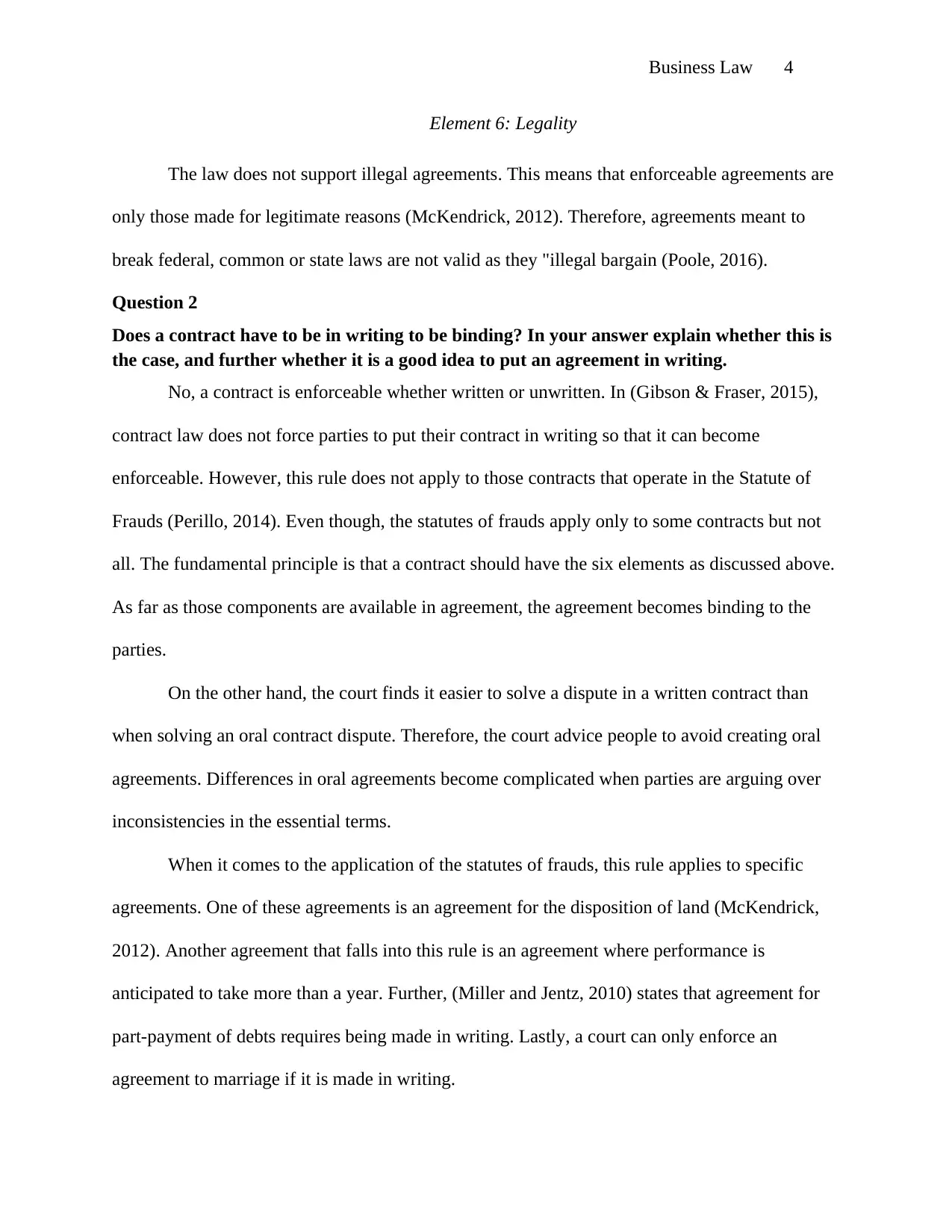
Business Law 4
Element 6: Legality
The law does not support illegal agreements. This means that enforceable agreements are
only those made for legitimate reasons (McKendrick, 2012). Therefore, agreements meant to
break federal, common or state laws are not valid as they "illegal bargain (Poole, 2016).
Question 2
Does a contract have to be in writing to be binding? In your answer explain whether this is
the case, and further whether it is a good idea to put an agreement in writing.
No, a contract is enforceable whether written or unwritten. In (Gibson & Fraser, 2015),
contract law does not force parties to put their contract in writing so that it can become
enforceable. However, this rule does not apply to those contracts that operate in the Statute of
Frauds (Perillo, 2014). Even though, the statutes of frauds apply only to some contracts but not
all. The fundamental principle is that a contract should have the six elements as discussed above.
As far as those components are available in agreement, the agreement becomes binding to the
parties.
On the other hand, the court finds it easier to solve a dispute in a written contract than
when solving an oral contract dispute. Therefore, the court advice people to avoid creating oral
agreements. Differences in oral agreements become complicated when parties are arguing over
inconsistencies in the essential terms.
When it comes to the application of the statutes of frauds, this rule applies to specific
agreements. One of these agreements is an agreement for the disposition of land (McKendrick,
2012). Another agreement that falls into this rule is an agreement where performance is
anticipated to take more than a year. Further, (Miller and Jentz, 2010) states that agreement for
part-payment of debts requires being made in writing. Lastly, a court can only enforce an
agreement to marriage if it is made in writing.
Element 6: Legality
The law does not support illegal agreements. This means that enforceable agreements are
only those made for legitimate reasons (McKendrick, 2012). Therefore, agreements meant to
break federal, common or state laws are not valid as they "illegal bargain (Poole, 2016).
Question 2
Does a contract have to be in writing to be binding? In your answer explain whether this is
the case, and further whether it is a good idea to put an agreement in writing.
No, a contract is enforceable whether written or unwritten. In (Gibson & Fraser, 2015),
contract law does not force parties to put their contract in writing so that it can become
enforceable. However, this rule does not apply to those contracts that operate in the Statute of
Frauds (Perillo, 2014). Even though, the statutes of frauds apply only to some contracts but not
all. The fundamental principle is that a contract should have the six elements as discussed above.
As far as those components are available in agreement, the agreement becomes binding to the
parties.
On the other hand, the court finds it easier to solve a dispute in a written contract than
when solving an oral contract dispute. Therefore, the court advice people to avoid creating oral
agreements. Differences in oral agreements become complicated when parties are arguing over
inconsistencies in the essential terms.
When it comes to the application of the statutes of frauds, this rule applies to specific
agreements. One of these agreements is an agreement for the disposition of land (McKendrick,
2012). Another agreement that falls into this rule is an agreement where performance is
anticipated to take more than a year. Further, (Miller and Jentz, 2010) states that agreement for
part-payment of debts requires being made in writing. Lastly, a court can only enforce an
agreement to marriage if it is made in writing.
Paraphrase This Document
Need a fresh take? Get an instant paraphrase of this document with our AI Paraphraser
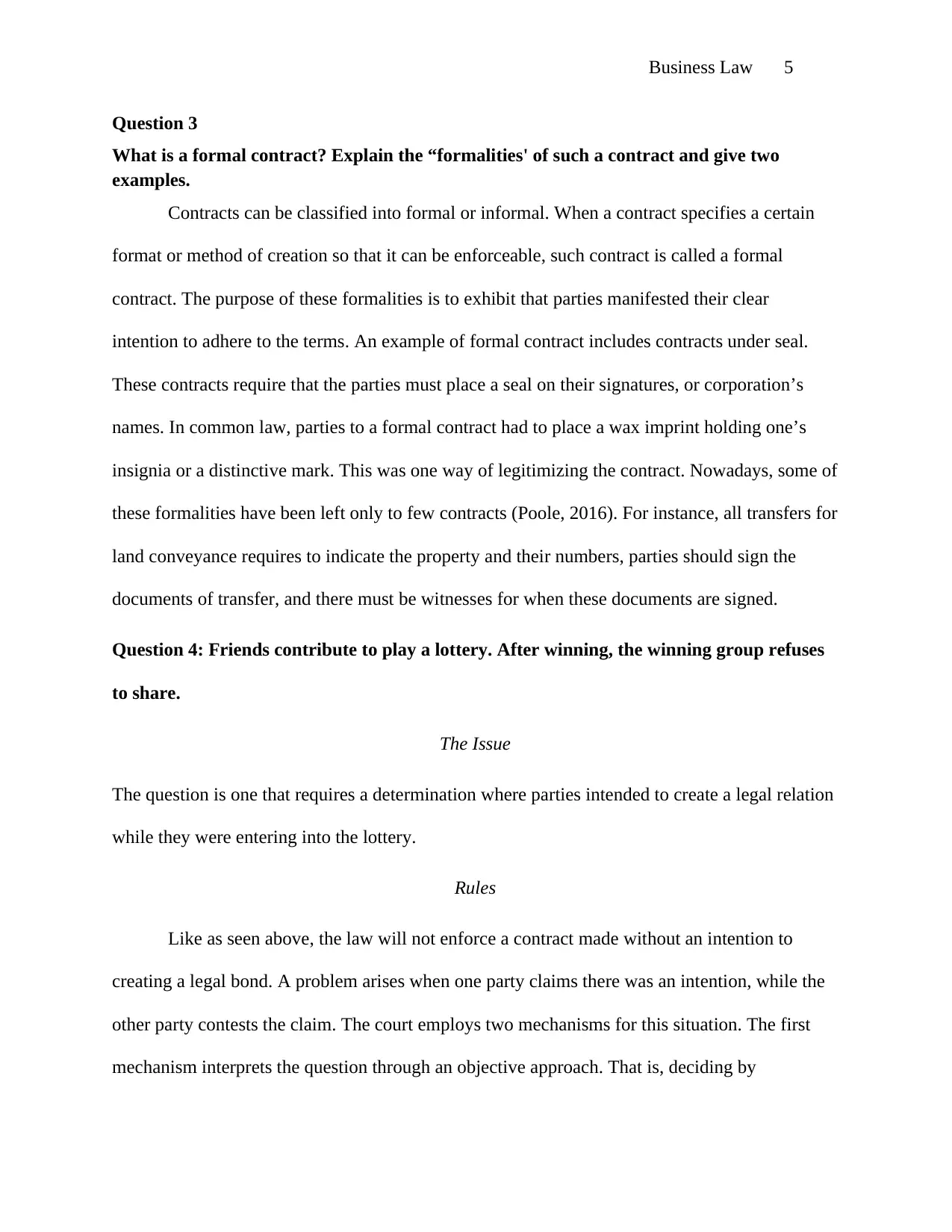
Business Law 5
Question 3
What is a formal contract? Explain the “formalities' of such a contract and give two
examples.
Contracts can be classified into formal or informal. When a contract specifies a certain
format or method of creation so that it can be enforceable, such contract is called a formal
contract. The purpose of these formalities is to exhibit that parties manifested their clear
intention to adhere to the terms. An example of formal contract includes contracts under seal.
These contracts require that the parties must place a seal on their signatures, or corporation’s
names. In common law, parties to a formal contract had to place a wax imprint holding one’s
insignia or a distinctive mark. This was one way of legitimizing the contract. Nowadays, some of
these formalities have been left only to few contracts (Poole, 2016). For instance, all transfers for
land conveyance requires to indicate the property and their numbers, parties should sign the
documents of transfer, and there must be witnesses for when these documents are signed.
Question 4: Friends contribute to play a lottery. After winning, the winning group refuses
to share.
The Issue
The question is one that requires a determination where parties intended to create a legal relation
while they were entering into the lottery.
Rules
Like as seen above, the law will not enforce a contract made without an intention to
creating a legal bond. A problem arises when one party claims there was an intention, while the
other party contests the claim. The court employs two mechanisms for this situation. The first
mechanism interprets the question through an objective approach. That is, deciding by
Question 3
What is a formal contract? Explain the “formalities' of such a contract and give two
examples.
Contracts can be classified into formal or informal. When a contract specifies a certain
format or method of creation so that it can be enforceable, such contract is called a formal
contract. The purpose of these formalities is to exhibit that parties manifested their clear
intention to adhere to the terms. An example of formal contract includes contracts under seal.
These contracts require that the parties must place a seal on their signatures, or corporation’s
names. In common law, parties to a formal contract had to place a wax imprint holding one’s
insignia or a distinctive mark. This was one way of legitimizing the contract. Nowadays, some of
these formalities have been left only to few contracts (Poole, 2016). For instance, all transfers for
land conveyance requires to indicate the property and their numbers, parties should sign the
documents of transfer, and there must be witnesses for when these documents are signed.
Question 4: Friends contribute to play a lottery. After winning, the winning group refuses
to share.
The Issue
The question is one that requires a determination where parties intended to create a legal relation
while they were entering into the lottery.
Rules
Like as seen above, the law will not enforce a contract made without an intention to
creating a legal bond. A problem arises when one party claims there was an intention, while the
other party contests the claim. The court employs two mechanisms for this situation. The first
mechanism interprets the question through an objective approach. That is, deciding by
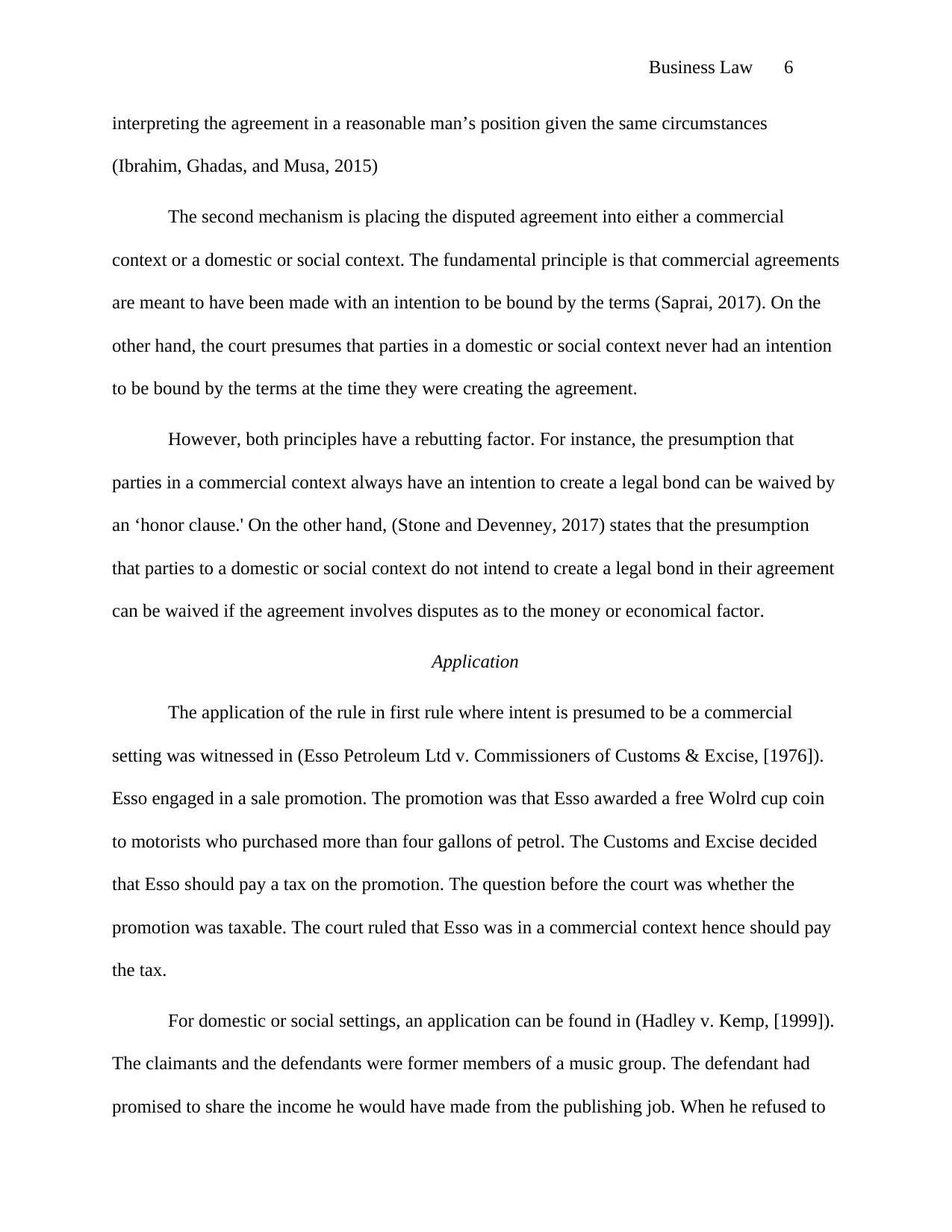
Business Law 6
interpreting the agreement in a reasonable man’s position given the same circumstances
(Ibrahim, Ghadas, and Musa, 2015)
The second mechanism is placing the disputed agreement into either a commercial
context or a domestic or social context. The fundamental principle is that commercial agreements
are meant to have been made with an intention to be bound by the terms (Saprai, 2017). On the
other hand, the court presumes that parties in a domestic or social context never had an intention
to be bound by the terms at the time they were creating the agreement.
However, both principles have a rebutting factor. For instance, the presumption that
parties in a commercial context always have an intention to create a legal bond can be waived by
an ‘honor clause.' On the other hand, (Stone and Devenney, 2017) states that the presumption
that parties to a domestic or social context do not intend to create a legal bond in their agreement
can be waived if the agreement involves disputes as to the money or economical factor.
Application
The application of the rule in first rule where intent is presumed to be a commercial
setting was witnessed in (Esso Petroleum Ltd v. Commissioners of Customs & Excise, [1976]).
Esso engaged in a sale promotion. The promotion was that Esso awarded a free Wolrd cup coin
to motorists who purchased more than four gallons of petrol. The Customs and Excise decided
that Esso should pay a tax on the promotion. The question before the court was whether the
promotion was taxable. The court ruled that Esso was in a commercial context hence should pay
the tax.
For domestic or social settings, an application can be found in (Hadley v. Kemp, [1999]).
The claimants and the defendants were former members of a music group. The defendant had
promised to share the income he would have made from the publishing job. When he refused to
interpreting the agreement in a reasonable man’s position given the same circumstances
(Ibrahim, Ghadas, and Musa, 2015)
The second mechanism is placing the disputed agreement into either a commercial
context or a domestic or social context. The fundamental principle is that commercial agreements
are meant to have been made with an intention to be bound by the terms (Saprai, 2017). On the
other hand, the court presumes that parties in a domestic or social context never had an intention
to be bound by the terms at the time they were creating the agreement.
However, both principles have a rebutting factor. For instance, the presumption that
parties in a commercial context always have an intention to create a legal bond can be waived by
an ‘honor clause.' On the other hand, (Stone and Devenney, 2017) states that the presumption
that parties to a domestic or social context do not intend to create a legal bond in their agreement
can be waived if the agreement involves disputes as to the money or economical factor.
Application
The application of the rule in first rule where intent is presumed to be a commercial
setting was witnessed in (Esso Petroleum Ltd v. Commissioners of Customs & Excise, [1976]).
Esso engaged in a sale promotion. The promotion was that Esso awarded a free Wolrd cup coin
to motorists who purchased more than four gallons of petrol. The Customs and Excise decided
that Esso should pay a tax on the promotion. The question before the court was whether the
promotion was taxable. The court ruled that Esso was in a commercial context hence should pay
the tax.
For domestic or social settings, an application can be found in (Hadley v. Kemp, [1999]).
The claimants and the defendants were former members of a music group. The defendant had
promised to share the income he would have made from the publishing job. When he refused to
⊘ This is a preview!⊘
Do you want full access?
Subscribe today to unlock all pages.

Trusted by 1+ million students worldwide
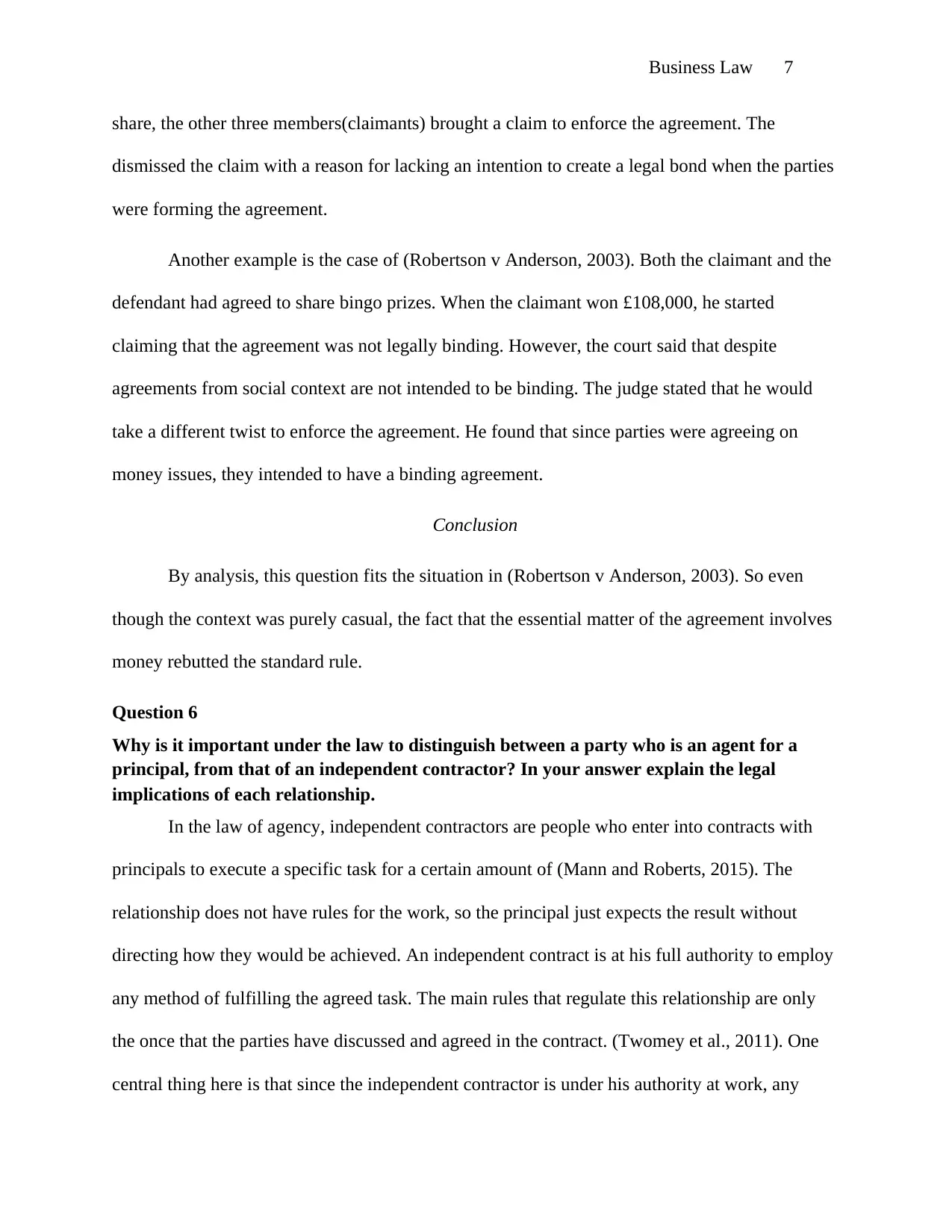
Business Law 7
share, the other three members(claimants) brought a claim to enforce the agreement. The
dismissed the claim with a reason for lacking an intention to create a legal bond when the parties
were forming the agreement.
Another example is the case of (Robertson v Anderson, 2003). Both the claimant and the
defendant had agreed to share bingo prizes. When the claimant won £108,000, he started
claiming that the agreement was not legally binding. However, the court said that despite
agreements from social context are not intended to be binding. The judge stated that he would
take a different twist to enforce the agreement. He found that since parties were agreeing on
money issues, they intended to have a binding agreement.
Conclusion
By analysis, this question fits the situation in (Robertson v Anderson, 2003). So even
though the context was purely casual, the fact that the essential matter of the agreement involves
money rebutted the standard rule.
Question 6
Why is it important under the law to distinguish between a party who is an agent for a
principal, from that of an independent contractor? In your answer explain the legal
implications of each relationship.
In the law of agency, independent contractors are people who enter into contracts with
principals to execute a specific task for a certain amount of (Mann and Roberts, 2015). The
relationship does not have rules for the work, so the principal just expects the result without
directing how they would be achieved. An independent contract is at his full authority to employ
any method of fulfilling the agreed task. The main rules that regulate this relationship are only
the once that the parties have discussed and agreed in the contract. (Twomey et al., 2011). One
central thing here is that since the independent contractor is under his authority at work, any
share, the other three members(claimants) brought a claim to enforce the agreement. The
dismissed the claim with a reason for lacking an intention to create a legal bond when the parties
were forming the agreement.
Another example is the case of (Robertson v Anderson, 2003). Both the claimant and the
defendant had agreed to share bingo prizes. When the claimant won £108,000, he started
claiming that the agreement was not legally binding. However, the court said that despite
agreements from social context are not intended to be binding. The judge stated that he would
take a different twist to enforce the agreement. He found that since parties were agreeing on
money issues, they intended to have a binding agreement.
Conclusion
By analysis, this question fits the situation in (Robertson v Anderson, 2003). So even
though the context was purely casual, the fact that the essential matter of the agreement involves
money rebutted the standard rule.
Question 6
Why is it important under the law to distinguish between a party who is an agent for a
principal, from that of an independent contractor? In your answer explain the legal
implications of each relationship.
In the law of agency, independent contractors are people who enter into contracts with
principals to execute a specific task for a certain amount of (Mann and Roberts, 2015). The
relationship does not have rules for the work, so the principal just expects the result without
directing how they would be achieved. An independent contract is at his full authority to employ
any method of fulfilling the agreed task. The main rules that regulate this relationship are only
the once that the parties have discussed and agreed in the contract. (Twomey et al., 2011). One
central thing here is that since the independent contractor is under his authority at work, any
Paraphrase This Document
Need a fresh take? Get an instant paraphrase of this document with our AI Paraphraser
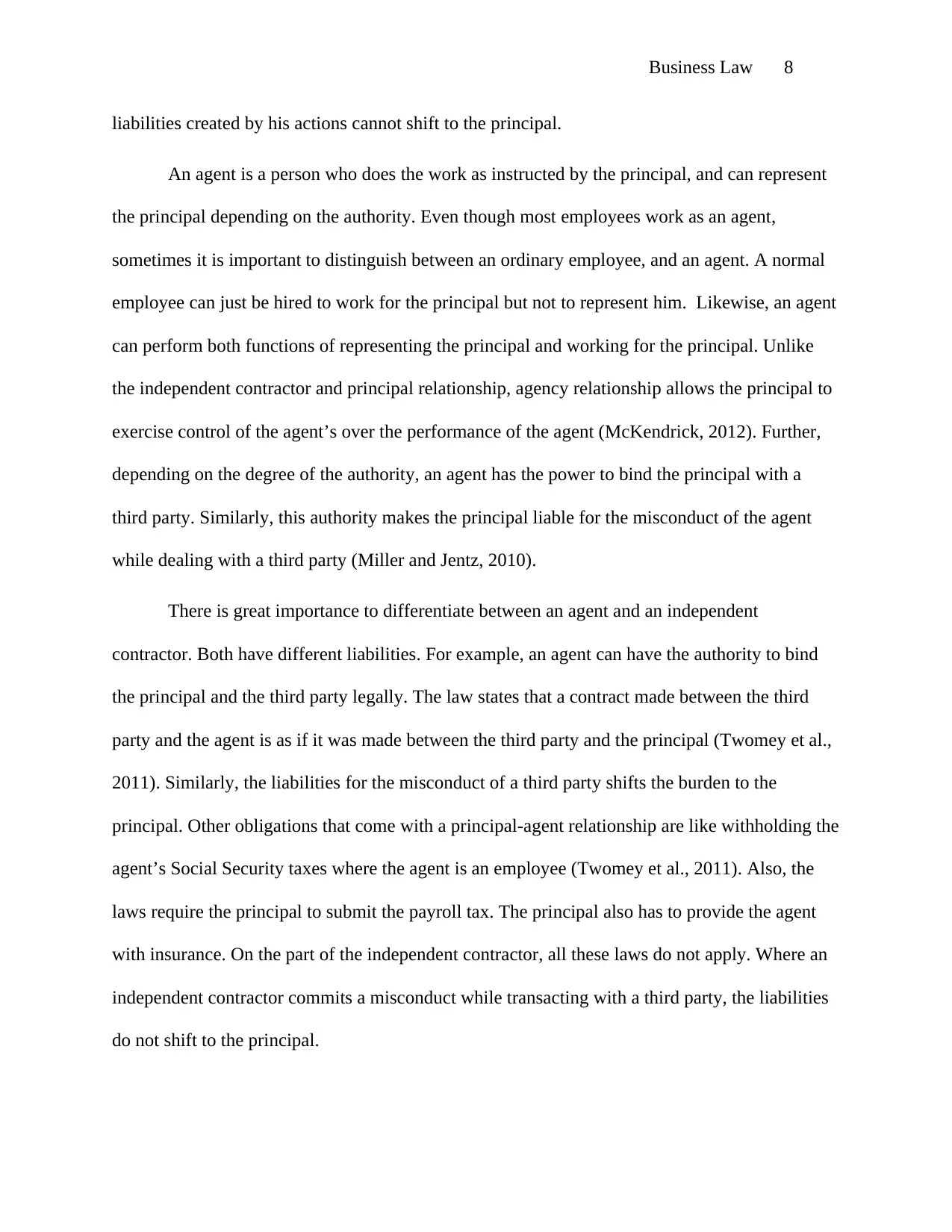
Business Law 8
liabilities created by his actions cannot shift to the principal.
An agent is a person who does the work as instructed by the principal, and can represent
the principal depending on the authority. Even though most employees work as an agent,
sometimes it is important to distinguish between an ordinary employee, and an agent. A normal
employee can just be hired to work for the principal but not to represent him. Likewise, an agent
can perform both functions of representing the principal and working for the principal. Unlike
the independent contractor and principal relationship, agency relationship allows the principal to
exercise control of the agent’s over the performance of the agent (McKendrick, 2012). Further,
depending on the degree of the authority, an agent has the power to bind the principal with a
third party. Similarly, this authority makes the principal liable for the misconduct of the agent
while dealing with a third party (Miller and Jentz, 2010).
There is great importance to differentiate between an agent and an independent
contractor. Both have different liabilities. For example, an agent can have the authority to bind
the principal and the third party legally. The law states that a contract made between the third
party and the agent is as if it was made between the third party and the principal (Twomey et al.,
2011). Similarly, the liabilities for the misconduct of a third party shifts the burden to the
principal. Other obligations that come with a principal-agent relationship are like withholding the
agent’s Social Security taxes where the agent is an employee (Twomey et al., 2011). Also, the
laws require the principal to submit the payroll tax. The principal also has to provide the agent
with insurance. On the part of the independent contractor, all these laws do not apply. Where an
independent contractor commits a misconduct while transacting with a third party, the liabilities
do not shift to the principal.
liabilities created by his actions cannot shift to the principal.
An agent is a person who does the work as instructed by the principal, and can represent
the principal depending on the authority. Even though most employees work as an agent,
sometimes it is important to distinguish between an ordinary employee, and an agent. A normal
employee can just be hired to work for the principal but not to represent him. Likewise, an agent
can perform both functions of representing the principal and working for the principal. Unlike
the independent contractor and principal relationship, agency relationship allows the principal to
exercise control of the agent’s over the performance of the agent (McKendrick, 2012). Further,
depending on the degree of the authority, an agent has the power to bind the principal with a
third party. Similarly, this authority makes the principal liable for the misconduct of the agent
while dealing with a third party (Miller and Jentz, 2010).
There is great importance to differentiate between an agent and an independent
contractor. Both have different liabilities. For example, an agent can have the authority to bind
the principal and the third party legally. The law states that a contract made between the third
party and the agent is as if it was made between the third party and the principal (Twomey et al.,
2011). Similarly, the liabilities for the misconduct of a third party shifts the burden to the
principal. Other obligations that come with a principal-agent relationship are like withholding the
agent’s Social Security taxes where the agent is an employee (Twomey et al., 2011). Also, the
laws require the principal to submit the payroll tax. The principal also has to provide the agent
with insurance. On the part of the independent contractor, all these laws do not apply. Where an
independent contractor commits a misconduct while transacting with a third party, the liabilities
do not shift to the principal.
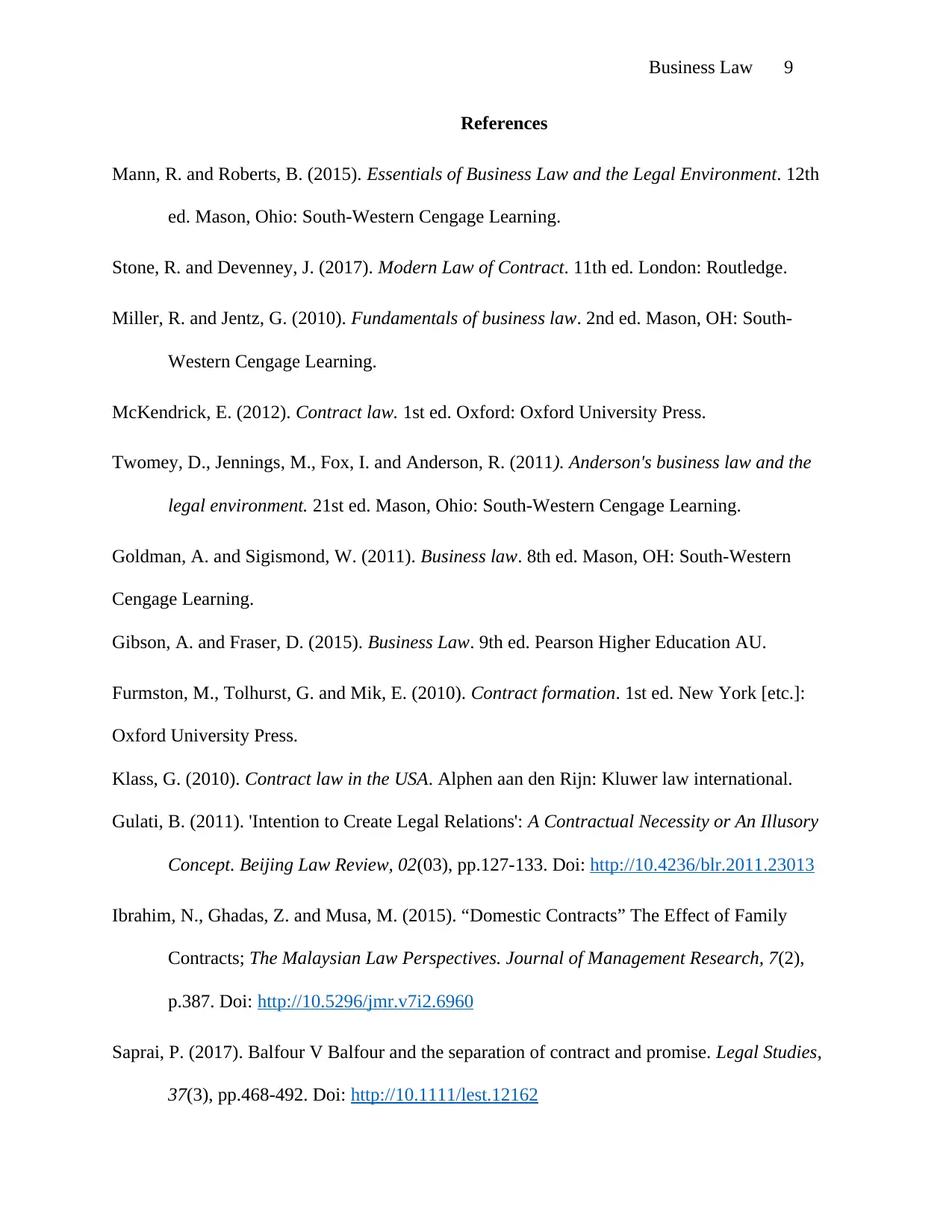
Business Law 9
References
Mann, R. and Roberts, B. (2015). Essentials of Business Law and the Legal Environment. 12th
ed. Mason, Ohio: South-Western Cengage Learning.
Stone, R. and Devenney, J. (2017). Modern Law of Contract. 11th ed. London: Routledge.
Miller, R. and Jentz, G. (2010). Fundamentals of business law. 2nd ed. Mason, OH: South-
Western Cengage Learning.
McKendrick, E. (2012). Contract law. 1st ed. Oxford: Oxford University Press.
Twomey, D., Jennings, M., Fox, I. and Anderson, R. (2011). Anderson's business law and the
legal environment. 21st ed. Mason, Ohio: South-Western Cengage Learning.
Goldman, A. and Sigismond, W. (2011). Business law. 8th ed. Mason, OH: South-Western
Cengage Learning.
Gibson, A. and Fraser, D. (2015). Business Law. 9th ed. Pearson Higher Education AU.
Furmston, M., Tolhurst, G. and Mik, E. (2010). Contract formation. 1st ed. New York [etc.]:
Oxford University Press.
Klass, G. (2010). Contract law in the USA. Alphen aan den Rijn: Kluwer law international.
Gulati, B. (2011). 'Intention to Create Legal Relations': A Contractual Necessity or An Illusory
Concept. Beijing Law Review, 02(03), pp.127-133. Doi: http://10.4236/blr.2011.23013
Ibrahim, N., Ghadas, Z. and Musa, M. (2015). “Domestic Contracts” The Effect of Family
Contracts; The Malaysian Law Perspectives. Journal of Management Research, 7(2),
p.387. Doi: http://10.5296/jmr.v7i2.6960
Saprai, P. (2017). Balfour V Balfour and the separation of contract and promise. Legal Studies,
37(3), pp.468-492. Doi: http://10.1111/lest.12162
References
Mann, R. and Roberts, B. (2015). Essentials of Business Law and the Legal Environment. 12th
ed. Mason, Ohio: South-Western Cengage Learning.
Stone, R. and Devenney, J. (2017). Modern Law of Contract. 11th ed. London: Routledge.
Miller, R. and Jentz, G. (2010). Fundamentals of business law. 2nd ed. Mason, OH: South-
Western Cengage Learning.
McKendrick, E. (2012). Contract law. 1st ed. Oxford: Oxford University Press.
Twomey, D., Jennings, M., Fox, I. and Anderson, R. (2011). Anderson's business law and the
legal environment. 21st ed. Mason, Ohio: South-Western Cengage Learning.
Goldman, A. and Sigismond, W. (2011). Business law. 8th ed. Mason, OH: South-Western
Cengage Learning.
Gibson, A. and Fraser, D. (2015). Business Law. 9th ed. Pearson Higher Education AU.
Furmston, M., Tolhurst, G. and Mik, E. (2010). Contract formation. 1st ed. New York [etc.]:
Oxford University Press.
Klass, G. (2010). Contract law in the USA. Alphen aan den Rijn: Kluwer law international.
Gulati, B. (2011). 'Intention to Create Legal Relations': A Contractual Necessity or An Illusory
Concept. Beijing Law Review, 02(03), pp.127-133. Doi: http://10.4236/blr.2011.23013
Ibrahim, N., Ghadas, Z. and Musa, M. (2015). “Domestic Contracts” The Effect of Family
Contracts; The Malaysian Law Perspectives. Journal of Management Research, 7(2),
p.387. Doi: http://10.5296/jmr.v7i2.6960
Saprai, P. (2017). Balfour V Balfour and the separation of contract and promise. Legal Studies,
37(3), pp.468-492. Doi: http://10.1111/lest.12162
⊘ This is a preview!⊘
Do you want full access?
Subscribe today to unlock all pages.

Trusted by 1+ million students worldwide
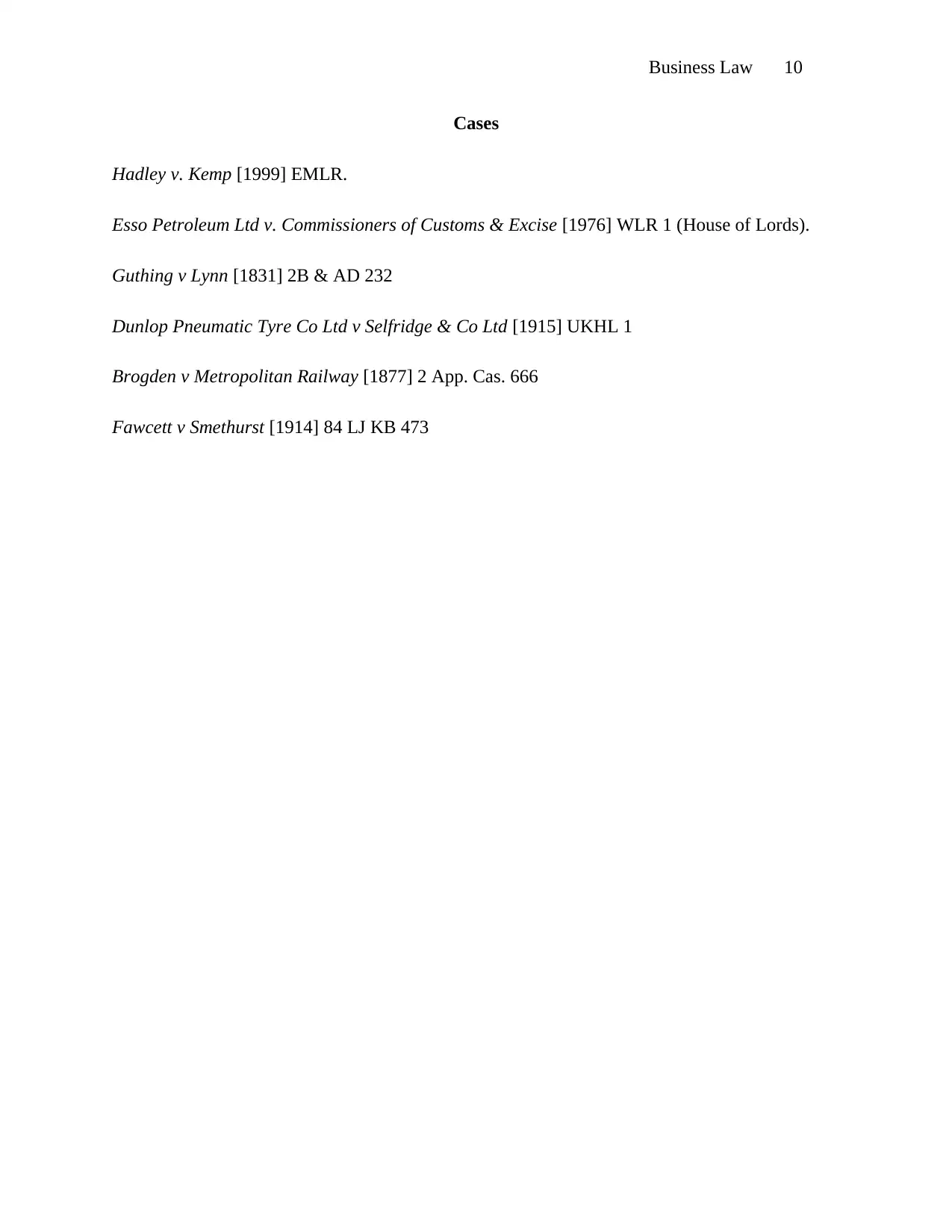
Business Law 10
Cases
Hadley v. Kemp [1999] EMLR.
Esso Petroleum Ltd v. Commissioners of Customs & Excise [1976] WLR 1 (House of Lords).
Guthing v Lynn [1831] 2B & AD 232
Dunlop Pneumatic Tyre Co Ltd v Selfridge & Co Ltd [1915] UKHL 1
Brogden v Metropolitan Railway [1877] 2 App. Cas. 666
Fawcett v Smethurst [1914] 84 LJ KB 473
Cases
Hadley v. Kemp [1999] EMLR.
Esso Petroleum Ltd v. Commissioners of Customs & Excise [1976] WLR 1 (House of Lords).
Guthing v Lynn [1831] 2B & AD 232
Dunlop Pneumatic Tyre Co Ltd v Selfridge & Co Ltd [1915] UKHL 1
Brogden v Metropolitan Railway [1877] 2 App. Cas. 666
Fawcett v Smethurst [1914] 84 LJ KB 473
1 out of 10
Related Documents
Your All-in-One AI-Powered Toolkit for Academic Success.
+13062052269
info@desklib.com
Available 24*7 on WhatsApp / Email
![[object Object]](/_next/static/media/star-bottom.7253800d.svg)
Unlock your academic potential
Copyright © 2020–2025 A2Z Services. All Rights Reserved. Developed and managed by ZUCOL.





